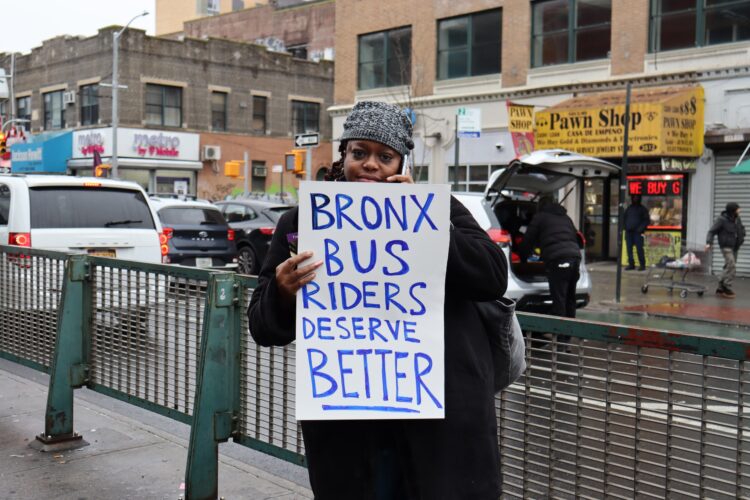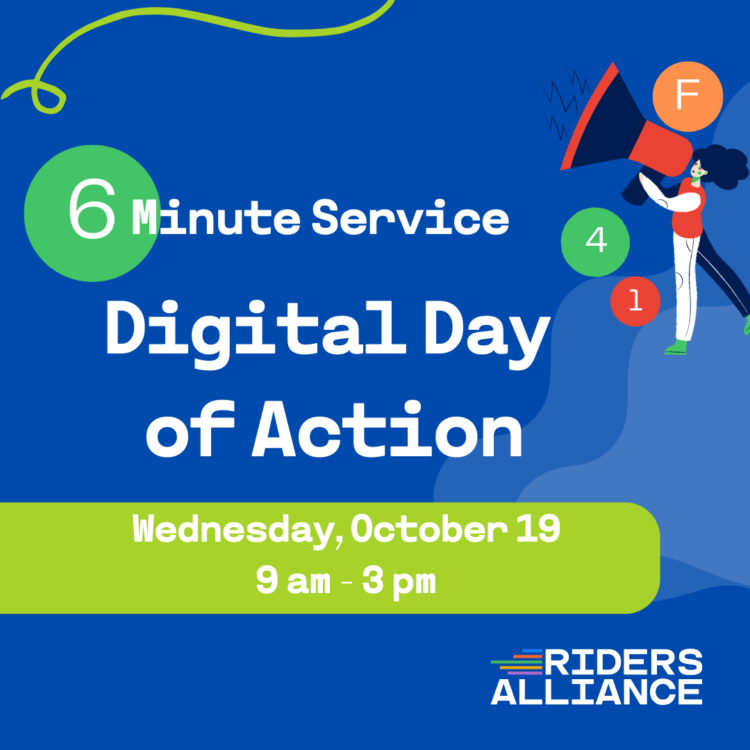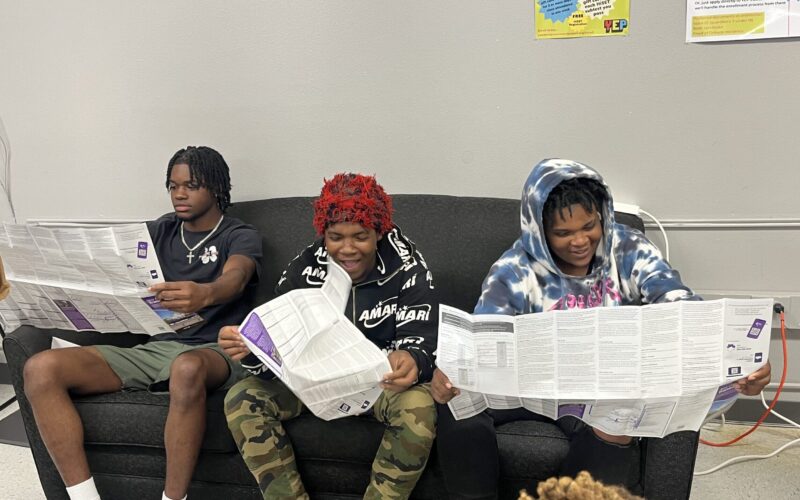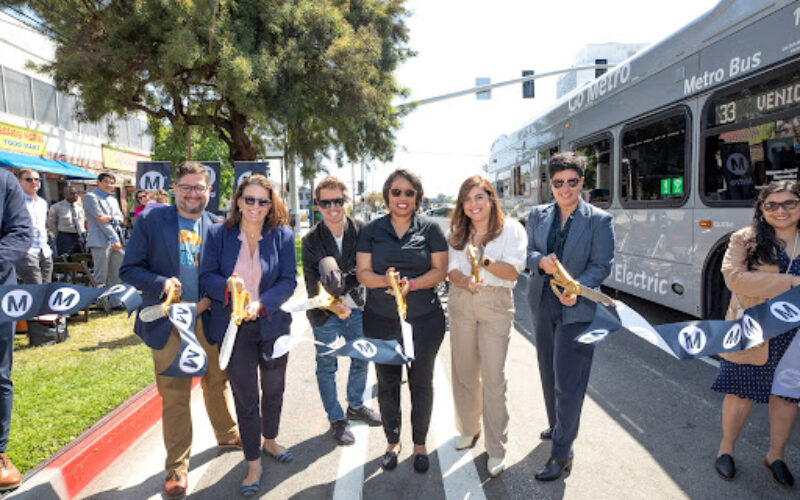
What your city can learn from #6minuteservice
In September 2022, Riders Alliance, a member-led transit advocacy group in New York City, launched a nine month-long campaign calling on Governor Kathy Hochul to invest in more frequent MTA service. And they won.
They did so in an immensely challenging fiscal environment. Ridership on the MTA has plateaued at around 70% of pre-pandemic numbers, as white-collar workers continue to work from home. As a result, the MTA was anticipating a $2.5 billion dollar operating deficit as soon as 2025, and planned to cut service on seven subway lines beginning in June of 2023. This would have impacted three million riders per day, many of whom are frontline and low-income workers who do not have other options for getting around.
But even without the prospect of service cuts, Riders Alliance recognized that the status quo wasn’t sufficient. While the MTA has still been running frequent peak-hour service, riders traveling on nights and weekends – where post-COVID ridership has been the highest – have been facing long and unpredictable waits between trains and buses.
In recognition that New Yorkers who rely on transit need more and better service – not less – Riders took their fight to Albany, where they won an infusion of new funding for the MTA during the 2023 state budget negotiations. Governor Hochul’s 2024 Executive Budget contains $1.1B in additional revenue to close the MTA’s budget gap, and a set-aside of $35 million to improve service frequencies. This funding will enable the MTA to run service every six to eight minutes on 12 subway lines during off-peak hours, weekends and weeknights, beginning this summer.
This is a big win for New York City subway riders, but the strategy and tactics Riders Alliance used are relevant to advocacy groups across the country.
What were the six elements of Riders Alliance’s winning strategy?
Talk to the Public, and Really Listen
In the summer of 2022, Riders Alliance staff members fanned out to bus stops and subway stations across the city as part of an effort they now refer to as the “Summer of Organizing.” There, they connected with daily transit riders, asking the same questions to everyone they spoke with: “What are your concerns? What do you need?” These conversations revealed that the number one priority for transit riders was more frequent service, which informed the contours of the campaign.
Riders Alliance’s Deputy Director Caitlin Pearce says that the “Summer of Organizing” also “grew the grassroots support we needed to launch the #6minuteservice campaign in the fall.” Riders was able to recruit 5,000 new members from this effort, many of whom played a key role throughout the campaign by volunteering to call, email, and tweet demands to elected officials, and attend rallies and speak to reporters.

A rider holds a sign saying, “Bronx Bus Riders Deserve Better.”
Identify Who Has the Power
In New York, the MTA budget is controlled by the governor, and every aspect of the #6minuteservice campaign led to Governor Hochul. Danny Pearlstein, Policy and Communications Director for Riders Alliance notes that “transit is one of the central public services in the city, and it’s the one provided by the governor.” As such, Riders Alliance strategically rallied their base, and found allies they knew held sway over Hochul.
Pearce adds that “targeting Governor Hochul, and making one person feel responsible for either delivering this benefit for riders or leaving them out in the cold, and finding ways to frame it that way, is really the most powerful thing you can do.”
Create a Memorable Message
Once Riders Alliance was clear that more frequent service was the goal and that Governor Hochul was the target, the team clarified “the ask.” The campaign slogan #6minuteservice emerged from a 2021 report from the New York City Comptroller. The Riders team felt that it was ambitious, possible, and packed a memorable marketing punch. As Pearce explains, the slogan had to make sense to someone who isn’t steeped in transit policy. “The train could come every six minutes? That sounds great!”
Make Every Event Count
Riders knew they faced an uphill battle to get and keep the attention of elected officials and press, many of whom rarely ride transit and hadn’t been personally affected by the MTA’s abysmal off-peak frequencies.
They kicked off the campaign with a big event timed with New York Climate Week, and maintained an aggressive, attention-grabbing event schedule to break through the noise and make sure everyone, especially Governor Hochul, became more aware of the problem. Whenever Riders held an in-person event, they paired it with a social media component, and asked attendees to tweet at their elected officials to demand more frequent service, tag @RidersAlliance in each tweet, post with the hashtag #6minuteservice, and tell their personal transit stories through Instagram Reels.
For one early campaign event, Riders Alliance staged a Digital Day of Action asking riders to share their stories that impact their lives on Twitter, Facebook, Instagram, and TikTok tagging the governor everytime their train was delayed.
During Halloween, Riders Alliance staged a commute dubbed Horrifying Headways Contest, asking riders to share their scariest wait times. The person with the longest wait – 47 minutes for a bus in Queens – won a metro card.
Riders Alliance piggybacked off of MTA’s monthly board meetings, too. Having the press and MTA regularly in the same room made it an unmissable opportunity to interject #6minuteservice into the conversation

Riders Alliance poster calling for riders to join the campaign for #6minuteservice’s Digital Day of Action on October 19, 2022.
Find Allies + Align Your Priorities
From the outset, Riders Alliance knew they needed a spectrum of support. Building a core base of support was the first step, and identifying the campaign target was the second. Then came building a coalition of supportive elected officials, the MTA and the TWU.
Elected Officials
By identifying sympathetic legislators and developing them into champions, Riders was able to dramatically boost the visibility of the campaign. In recognition that electeds are constantly asked for support and their attention is limited, Riders’ ask to them was clear and direct: Will you fight for this (more frequent service)? Will you commit to spending your political capital?
Riders Alliance was able to garner the support of a constellation of New York City elected officials, including New York City’s Public Advocate as well as state assemblymembers and senators whose constituents were suffering as a result of the MTA’s infrequent service.
As each elected member joined rallies, spoke with constituents, and were quoted in articles, their support raised the public profile of #6minuteservice, and helped to bring it to Governor Hochul’s attention.
The MTA & Transit Workers Union
Riders aimed to work in partnership with the MTA towards shared goals. To that end, Riders Alliance made sure to align their campaign ask with needs the agency had already identified. In the summer of 2022, MTA CEO Janno Leiber was already lobbying for $1B in annual funds for the MTA to close COVID-related budget gaps. Then Riders Alliance identified that it would take an additional $300M to increase frequency.
Using data from the Comptroller’s report, Riders Alliance reached out to contacts at MTA explaining why they believed #6minuteservice was possible. But they were repeatedly told different variations of, “there’s no money in the state budget; the MTA is bleeding money.”
The MTA later changed course and shared a scenario with Riders of how much service the agency could potentially run if the governor approved $300M in additional operating funds. This marked a turning point in the campaign, and shifted the conversations Riders was having with elected officials from “wouldn’t it be great if…” to hard data showing them what increased service could do for their constituents.
Riders also recognized the importance of garnering support for the campaign from TWU – the union that represents MTA workers. Though the union was involved in contract negotiations which kept them from participating fully, their eventual endorsement of #6minuteservice was pivotal to getting the campaign across the finish line, says Pearlstein.
Work the Media
Riders Alliance knew the best way to get elected officials to feel the heat was through the use of print and news media, so they hit the media circuit from every angle to ensure #6minuteservice was omnipresent. “In terms of the press [in New York], we have an embarrassment of riches compared to many places. And we make very, very aggressive use of it,” explains Pearlstein.
The team began by inviting elected officials to events, creating opportunities for them to meet with their constituents, and followed up by asking them to commit their support publicly, which they knew could make news.
Riders researched individual reporters, and familiarized themselves with their beats and stories, so they knew who they were talking to, and potential angles the reporter might want to focus on. Riders trained staff and volunteers with talking points to stay on message. And Riders pushed for everyone participating in the campaign to leverage the press and social media by making the riders’ experience visceral, constantly. “Make everything about your issue. Be as specific as possible. Make transit relevant,” advises Pearlstein.
The number of press hits Riders Alliance garnered for the campaign confirms the efficacy of their strategy. And when they weren’t able to reach the media, they penned an op-ed in Crain’s New York Business – an influential publication among elected officials.
The Win in Context
Transit is an essential public service, and the success of #6minuteservice demonstrates the positive changes that can happen with a well-thought out, diligent campaign designed to make an issue irresistible in the minds of the public, electeds, and the media.
Reflecting on the win, Pearlstein says that “six minute service gives us all better access to the city that belongs to us, but which we have trouble reaching. And it shrinks the city a little bit at a time when people are being pushed to the edges. Our transit system has a lot more potential left in it, and this gets us closer to delivering on its promise.”
 Winning Free Fares for Youth in New Orleans
Winning Free Fares for Youth in New Orleans
Most transit agencies rely on fare revenue to fund operations, meaning many are forced into the position of needing to collect fares from the people who can least afford it. To change this paradigm, advocates across the country are fighting for - and winning - programs that allow agencies to zero out fares for youth, removing one of the largest barriers to youth ridership.
Read More LA is (Not-So) Quietly Adding a LOT of Bus Lanes
LA is (Not-So) Quietly Adding a LOT of Bus Lanes
Thanks to the persistent work of local transit advocates, LA Metro is laying down 30 miles of bus lanes in 2023, pushing the total number of bus lanes in LA County to 40 miles.
Read More